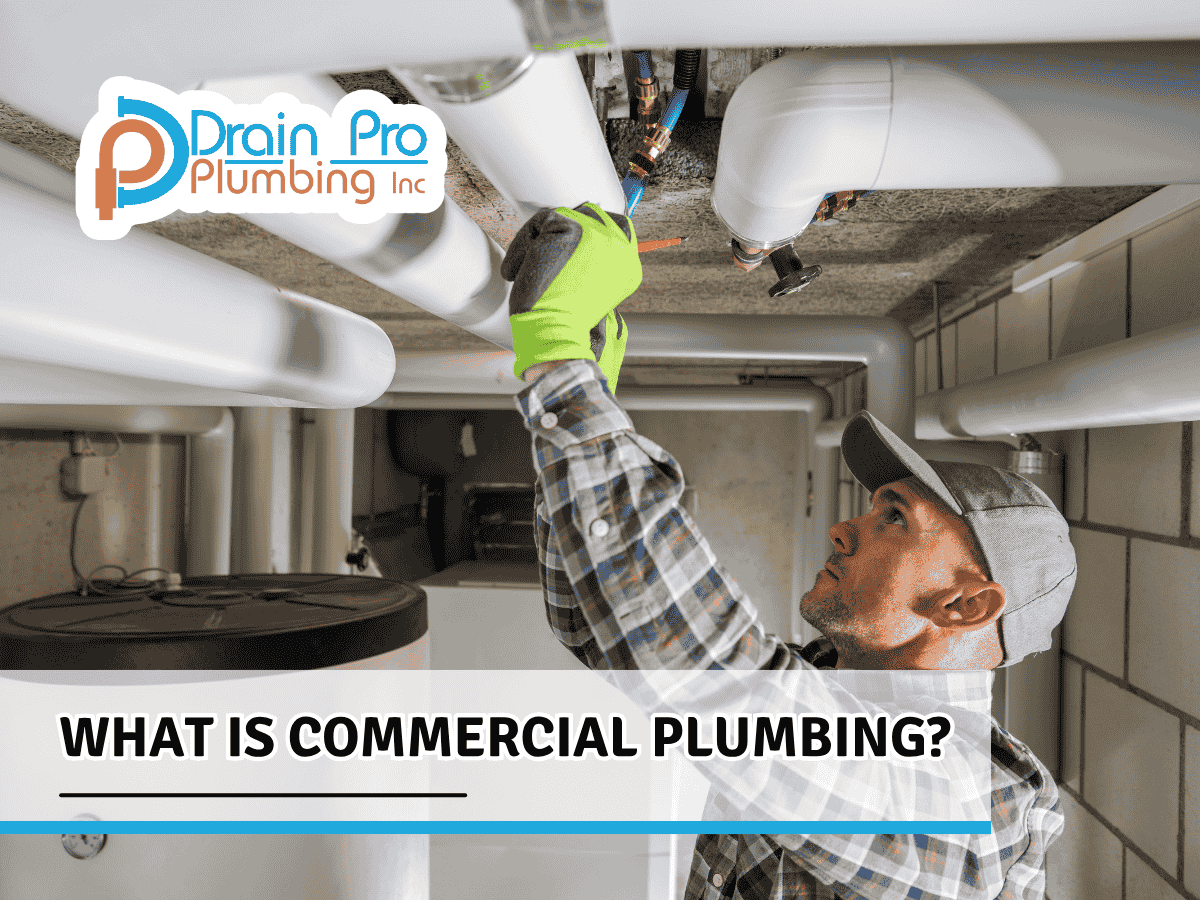What Is Commercial Plumbing? Things Every Roofer and Property Owner Should Know

When you think about commercial building systems, plumbing may not be the first thing that comes to mind—but it should be. Whether you’re constructing a high-rise, managing a restaurant, or retrofitting a school, plumbing is foundational to how the building functions.
So, what is commercial plumbing, and why does it matter to roofers, contractors, and building owners? The answer lies in how large-scale plumbing systems support essential utilities like water supply, drainage, and waste management—often overlapping with roofing tasks like roof drain integration and vent penetration.
At Drain Pro Plumbing & Septic, we’ve worked on countless commercial plumbing services across Kent and surrounding areas, ensuring every job meets local codes, functions efficiently, and supports the building’s structure, including the roof.
Understanding What Is Commercial Plumbing
Commercial plumbing refers to the complex mechanical systems installed in non-residential buildings to manage water supply, wastewater removal, and fixture installation. It differs from residential plumbing not only in scale but also in design, regulatory compliance, and operational demands.
Key Systems in Commercial Plumbing
- Water supply and pressure systems (including booster pumps and pressure-reducing valves)
- Wastewater and drainage networks for kitchens, bathrooms, and laundry facilities
- Grease management systems, essential in foodservice environments
- Roof drains and stormwater management systems
- Specialty systems, such as those for medical gas or industrial fluid handling
Typical Applications
- Office complexes
- Manufacturing plants
- Schools and universities
- Medical centers and clinics
- Apartment complexes and mixed-use developments
These environments demand not only greater volume handling but often custom plumbing designs that fit the building’s use type and local regulations. Plumbing contractors working on commercial systems must be familiar with these nuances.
Key Components of a Commercial Plumbing System
Water Supply Systems
- Connects directly to municipal water mains with larger service lines
- Often includes backflow preventers to safeguard potable water
- Pressurized systems must accommodate various fixtures across multiple floors
- Requires large-capacity water heaters or tankless systems for demand management
Waste and Drainage Systems
- Built for high usage and must manage diverse waste sources
- Utilize slope-graded piping and venting to move waste efficiently
- Includes complex drain networks below slab level in large structures
- Essential for code compliance and occupant health
Fixtures and Appliances
- Heavy-duty commercial toilets, urinals, and sinks made to withstand heavy use
- Breakroom kitchens with dishwashers and garbage disposals
- Fixtures often sensor-based for hygiene and water conservation
- Fire suppression and eyewash stations in industrial and healthcare settings
Roof Drainage and Venting
- Essential in flat-roof structures to prevent water pooling
- Requires integration of roof drains, overflows, and scuppers
- Plumbing vents extend through the roof and must be waterproofed
- Incorrect installation can cause severe roof leaks and damage
How Plumbing Affects Roofing in Commercial Projects
Roof Drainage Integration
Flat and low-slope commercial roofs rely heavily on plumbing systems to manage stormwater runoff. Drain placement, sizing, and piping directly affect how efficiently water is removed from the roof.
Improper drainage can lead to:
- Ponding water
- Membrane degradation
- Structural sagging or leaks
Pipe Penetrations and Waterproofing
- Vents, HVAC conduits, and drainpipes that exit through the roof need meticulous flashing
- Improper sealing causes long-term leaks and rot within the roof structure
- Coordination between roofing and plumbing contractors avoids future rework
Coordination During Construction or Renovation
- Plumbers must know the roof plan to prevent conflicts with trusses, insulation, and access points
- Roofing teams must install flashing and roofing materials after plumbing penetrations are finalized
- Proper scheduling reduces delays and material waste
Why Work With Code-Compliant Plumbing Contractors
In commercial buildings, roofing and plumbing are more intertwined than most people realize. Working with code-compliant plumbing professionals ensures:
- Proper load and drainage design: Drain Pro Plumbing & Septic ensures your building’s roof and plumbing can handle rain events without failure
- Fewer maintenance issues: Clean penetrations, aligned vent stacks, and correct drainage angle
- Legal compliance: We build to local and international code, avoiding violations
- Waterproofing assurance: Our work ensures all rooftop plumbing is watertight, reducing long-term costs
Roofers can’t work in isolation. When roof penetrations or drainage is involved, the success of your roofing system partly depends on how well the plumbing integrates—and that’s where we come in. Our commercial plumbers are trained to coordinate across trades.
Final Thoughts
Understanding what is commercial plumbing helps every stakeholder—from building owners and project managers to general contractors and roofers—design and maintain better structures. At Drain Pro Plumbing & Septic, our commercial plumbing work doesn’t just meet code—it’s built to perform over decades.
We approach every project with a holistic mindset, ensuring your plumbing supports your entire building system, from the foundation to the roof. Whether we’re handling roof drain systems, waste lines, or vent stacks, our work is always coordinated, compliant, and clean.
If you’re planning a commercial roofing project, don’t leave plumbing as an afterthought. Partner with a team that gets the big picture.
FAQs About Commercial Plumbing
What is commercial plumbing used for?
Commercial plumbing is used to manage water supply, waste removal, and fixture functionality in non-residential buildings like schools, offices, and hospitals.
How is commercial plumbing different from residential plumbing?
It involves more complex systems, larger pipe networks, higher water pressure, and must meet stricter code requirements due to the scale and usage demands.
Why does roofing need to coordinate with commercial plumbing?
Because internal roof drains and vent stacks are part of the plumbing system and must be sealed and integrated correctly to avoid leaks or water damage.
Who is responsible for roof drain installation in commercial buildings?
Plumbing contractors typically handle roof drain connections, while roofing contractors ensure proper waterproofing and flashing where those systems penetrate the roof.
What services fall under commercial plumbing?
They include water supply system design, waste and drainage, fixture installation, roof drainage integration, repiping, leak detection, and system maintenance.
Contact Us: Your Local Commercial Plumbing Experts in Kent
Drain Pro Plumbing & Septic proudly serves Kent and the surrounding areas, including King and Pierce Counties. Since 2010, we’ve been delivering plumbing and septic services that meet the highest industry standards.
We are your neighborhood plumbing team, known for precision, professionalism, and a 4.9-star local reputation. Our family-run team is deeply rooted in this community, and we’re proud to bring years of experience and youthful innovation to every job.
Why Property Owners Trust Us:
- $99 Drain Cleaning
- Emergency Services Available
- Licensed, Bonded, and Insured in WA
- A+ BBB Rated & Angi Certified
- Transparent Pricing & Friendly Support
Phone: (206) 765-0105
We specialize in everything from sewer repair and hydrojetting to leak detection and tankless water heater installation. Whether you’re a property manager, business owner, or builder—Drain Pro is the partner you can count on for all commercial plumbing needs.
Drain Pro Plumbing & Septic — When You’re Stuck, We’re the Best for Your Buck.


